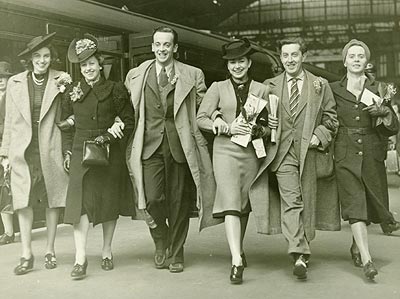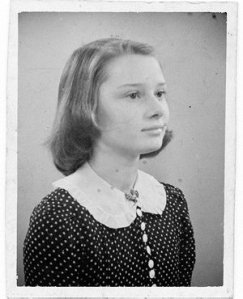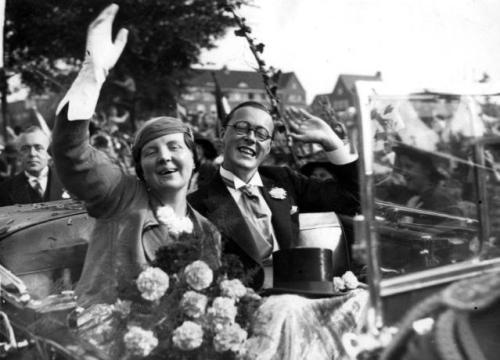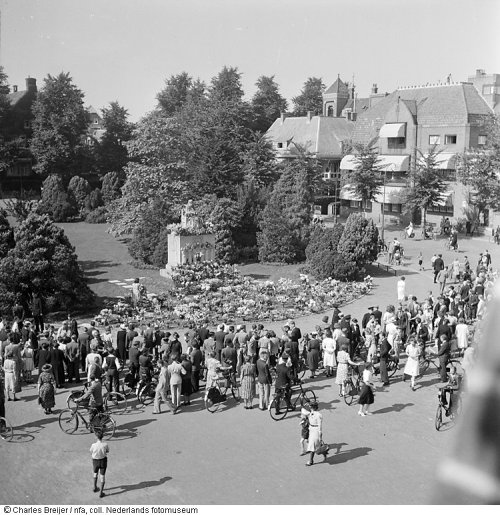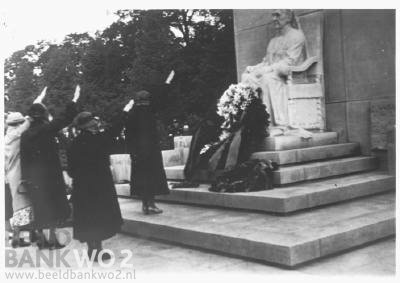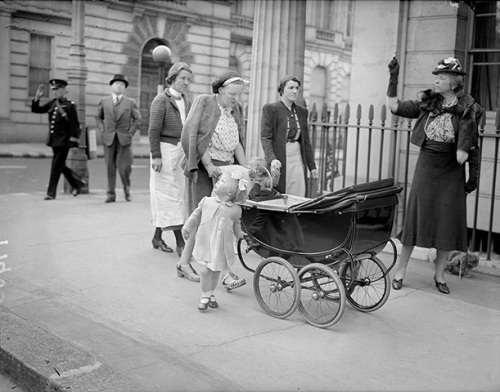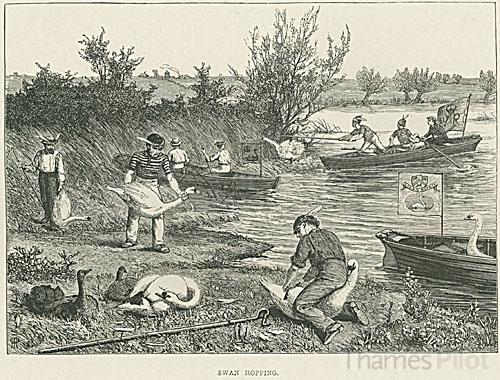Agatha Christie (1890-1976) never outgrew her childhood love of sea bathing. She spent her early years in the coastal town of Torquay, England, in Devon, on the English Channel. In summer, she swam in the sea practically every day, even if it rained or stormed. Not only locals like Agatha enjoyed Torquay’s beaches. Torquay [tor-kee] was a posh seaside resort, a popular winter and summer holiday destination for wealthy Europeans and royal personages. With its reputation for a healthful climate, the area is called the English Riviera.
When Agatha was a young girl, the beaches in Torquay were segregated by sex. The Torquay Council kept a strict watch on the propriety of sea bathing. In 1899, a bylaw stated that “no person of the male sex shall at any time bathe within 50 yards of a ladies’ bathing machine.” Men and boys swam at the Gentlemen’s Bathing Cove where there was no dress code. Men swam there in the nude or “in their scanty triangles,” Agatha recalled, “disport[ing] themselves as they pleased.” Women and girls were restricted to swimming at the Ladies’ Bathing Cove. Their beach was small and stony, and steeply sloping.
The Ladies’ Bathing Cove, Torquay, England, where crime author Agatha Christie bathed in the sea. Note the bathing machines at the shoreline. Undated photo
The women swam in pantaloons and frilly dresses that covered them up.
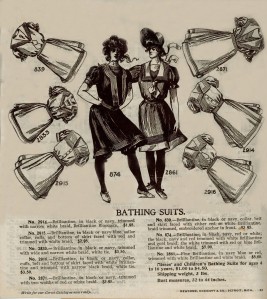
A page from a Newcomb Endicott Company Spring Catalog, ca. 1910. Most women sewed their own bathing suits.
Agatha loved going to the Ladies’ Bathing Cove with her family. Once there, Agatha’s mother and grannie would stake out a spot on the beach with their picnic things, but Agatha couldn’t wait to plunge into the surf. She changed into her swimsuit in one of the 8 bathing machines parked near the water’s edge. Bathing machines were private, portable changing rooms on wheels.
Once inside the machine, “an ancient man, of somewhat irascible temper” picked up the “gaily painted striped affair” and hauled it down the hill and into the water. Agatha exited the bathing machine, stepping down a short ladder into the chilly waters of the English Channel.
Agatha would then swim out to an anchored raft, pull herself up, and then sit upon it, sunning. Getting to the raft was a minor feat in itself, even though Agatha was a strong swimmer, because once in the water, her woolen swimsuit became completely sodden and heavy, making her sink under its weight. Women sewed weights in the skirt hems to keep them from rising up in the water, compounding the problem. It was a recipe for disaster: women sinking under the weight of cumbersome dresses, women who could not swim, crashing waves, no lifeguards, and water so frigid that limbs went numb and faces blue. Only some beaches had attendants to help women in the surf and ropes to hold onto.
Trivial matters like safety aside, what really occupied everyone’s mind at the Turn of the Century in England was protecting women’s modesty. The beach at the Ladies’ Bathing Cove was immensely private; it was completely invisible from the windows of the Torbay Yacht Club situated above it on the hill.
The beach may have been ultra-secluded but the sea around the raft was not. It was perfectly visible through the club windows. In her autobiography, Agatha wrote:
…[A]ccording to my father, a good many of the gentlemen spent their time with opera glasses enjoying the sight of female figures displayed in what they hopefully thought of as almost a state of nudity! I don’t think we can have been sexually very appealing in those shapeless garments.”
In 1903, when Agatha was 13, the Torquay Council approved mixed bathing on its beaches. Men and women could now frolic in the surf together at Tor Abbey Sands and Corbin’s Head Beach, as well as on the more aristocratic Meadfoot Beach, the one Agatha’s mother’s preferred.

Here is a mixed group of bathers photographed in Eastbourne around 1906. Mixed bathing in England became widely accepted at about this time.
Although allowing the sexes to mingle was considered to be a very progressive social move, ironically, it placed an even heavier burden on the women. In order to properly mix with men on the beach, Victorian standards of modesty dictated that women had to wear far more clothing than before! It was strictly forbidden for women to let their bare legs show. To caps, dresses, bloomers, and shoes, they added thick, black stockings. Agatha remembered the taboo against legs:
I really don’t know why legs were considered so improper: throughout Dickens there are screams when any lady thinks that her ankles have been observed. The very word was considered daring. One of the first nursery axioms was always uttered if you mentioned those pieces of your anatomy:
‘Remember, the Queen of Spain has no legs.’
‘What does she have instead, Nursie?’
‘Limbs, dear, that is what we call them; arms and legs are limbs.'”
At first, Agatha’s mother insisted that Agatha wear stockings to the beach, but:
Three or four vigorous kicks when swimming, and my stockings were dangling a long way beyond my toes; they were either sucked off altogether or else wrapped round my ankles like fetters….”

1907 studio photo of famous champion Australian swimmer and silent Hollywood film star, Annette Kellerman. Her contribution to women’s liberation was her advocacy of a comfortable women’s swimsuit.
Australian swimmer, diver, and entertainer Annette Kellerman – “The Diving Venus” – set out to challenge legal restrictions on women’s bathing suits. She believed that swimming was the ideal exercise for women and that pantaloons and skirts prohibited free movement, allowing women only a dip, not a swim, in the life-giving sea. Kellerman was well-known in Britain. In 1904 she swam 26 miles of the River Thames, performed underwater ballet in a glass tank at the London Hippodrome, and tried (and failed) three times to swim the English Channel.
In 1907, preparing for a promotional coast swim, Kellerman was arrested for indecent attire on Revere Beach, Boston, in America. She was wearing one of her clinging, one-piece swimsuits that had no skirt, revealing her thighs.
Kellerman pleaded her case before the judge. Her swimsuit, she explained, was practical, not provocative. Swimming in a Victorian swimsuit with its
‘shoes, stockings, bloomers, skirts, corsets and a dinky little cap,’ she said, made as much sense as ‘swimming in lead chains.'”
The judge dismissed the case, accepting Kellerman’s arguments in favor of swimming as healthy exercise and against cumbersome bathing suits, provided she wore a robe until she entered the water. Her arrest made international headlines. It was the birth of Twentieth Century bathing suits for women; from then on, swimsuits began to be designed for more practical use.

Wearing modern one-piece suits inspired by swimmer Annette Kellerman, women bathers gather seaweed and laugh. Aberystwyth, Cardiganshire in Wales, 1916
Source: Christie, Agatha. Agatha Christie: An Autobiography. New York: Berkley Books, 1977.
For more on Agatha Christie, click here.















